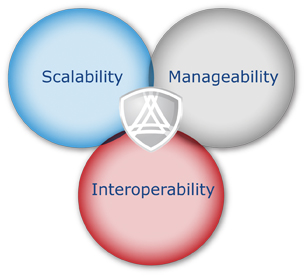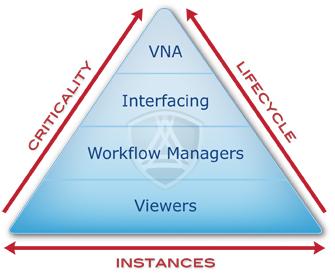
Let’s face it, vendor neutral archive (VNA) is a hot topic these days and one you cannot avoid. Unfortunately, and much like the overly used and tiring buzzword “cloud,” the term VNA becomes a nebulous descriptor when comparing multi-vendor platform offerings. Although a gut feeling instinct to drive or kill this new initiative is immediately felt (visceral experience), driving an “apples-to-apples” RFP process can become a daunting task of fine print and between-the-lines exercises. Others may defer to their existing vendor for the solutions that may leave them without the feature, functions or future capabilities they will need.
These line-level details generally result in blurry vision, scratching heads and scrambling for the best technical translator scrounged up from the nearest IT closet. Without a firm expectation of what your shiny new VNA could and (more importantly) should do, implementations can produce three very different results.
• Wasteful — unutilized or unneeded functionality
• Deficient — missing or misrepresented functionality
• Optimal — a highly effective and utilized imaging archive
Worse yet, implementing a solution that is both wasteful and deficient can be irreconcilable without considerable additional cost, time and inconvenience. To avoid a potential career-ending move, understanding exactly what a full VNA can provide is critical for defining the success criteria of your implementation. Cost is always a consideration, but at this stage you’ve already gambled heavily (hopefully not struggling with unfavorable results) or looking to drive initiatives by virtue of vendor comparison.
Let’s first look at critical top-level capabilities you should expect from the new system. No single capability outweighs another and all must be considered when validating a full VNA platform. A top-down perspective will help identify if the platform is truly a VNA more easily than getting lost in feature functionality. As a side note for future exploration, if a feature does not fit within a high-level capability, it’s a “value-add” and outside of the scope of a core VNA offering. “Value-add” functionality may be important, but not to serve as a distraction from core competency of the system. Every full VNA should have the following high-level capabilities:
• S — Scalability
• I — Interoperability
• M — Manageability
Now, let’s distill the three individual capabilities into easily digestible feature functionality.
Scalability — Expanding With theImaging Horizon
Infrastructure. Infrastructure scalability is now a well-understood methodology that should contain virtualization capability, high availability for business continuity, and a system’s ability to attach additional cost-effective storage media with nominal impact to the operating environment. Infrastructure scalability also includes the ability to add these media types (such as performance-driven hierarchical storage capabilities) in accordance with access and retention requirements of the data contained on the media. Deploying or scaling the VNA hardware platform allows administrators to openly conform to procurement standards while taking advantage of economies of scale present in the current enterprise environment. This is a major benefit when considering the maintenance and support of proprietary and inflexible storage methods deployed within common picture archiving and communication system (PACS) environments.
Departmental. Although scalability is commonly assumed as a platform’s ability to expand based on the infrastructure growth and utilization, scalability must also include the ability to span areas of operational needs. The continual push for an economically viable and consolidated storage solution for the entire enterprise imaging platform requires the VNA must be able to handle imaging beyond radiology. The misconception that “images” reside only within the radiology practice is finally giving way to appreciation for all other practices producing image objects. These image objects include not only modality captured images, but scanned documents, non-diagnostic device imagery (mobile and ancillary devices) and other “images” captured with an image-based format.
Together, this means the VNA storage methodology must be able to scale with future imaging infrastructure expansion as well as digesting new specialties introduced to the system. All of this while sustaining an interchangeable platform for workflow management, image acquisition and storage, and viewing capabilities without the need for continual data format conversion or interfacing.
Interoperability — Stratifying Your Technology
Architecture. Although it’s critical to maintain a scalable environment across the imaging enterprise, ensuring existing systems can interact efficiently is key to interoperability. A full VNA’s modular approach to interoperability allows for a stratified technology structure with the VNA sitting at the core of the system. This provides architects and administrators the capability to layer enterprise technology based on interconnectivity requirements, system criticality, lifecycle management and frequency of instances of the attached modules.
The diagram above represents how the VNA sits in respect to other components within a layered model. Simply stated, the VNA provides the highest criticality, least frequent replacement and least instances present within the environment. Exploiting the stratified model and interoperability allows for modular addition or deletion of technologies further down in the layers with nominal impact to the core imaging structure.
Interfacing. To accomplish interoperability, a VNA must maintain open standards and a hardware agnostic approach. Open standards simply mean a system’s capability to interact between open source systems and propriety systems, seamlessly. Regardless of existing infrastructure components and imaging systems, the VNA must act as a single point of integration by employing interface methods suitable to exchange data between all systems. A full VNA must be capable of a broad assortment of interoperability such as IHE (XDS), CMIS, file exchange, Web DAV, HL7, DICOM and vendor APIs.
Image Viewing. Viewing of acquired images is accomplished by providing a flexible method for presenting DICOM and non-DICOM data to the end user. Typical DICOM viewers (radiology for example) contain robust toolsets unique to the diagnostic imaging practice. But, these tools may not be effective or desired for images retained by cardiology departments or labs, for instance. These practices may require unique DICOM and non-DICOM viewers that can access and display images with viewer preferences evolved in accordance with the specific use case. A full VNA accomplishes this with three methods:
1. A unified viewer integration
2. Best of breed third party DICOM viewer integration
3. Fully integrated viewer for DICOM and non-DICOM objects
It is important to note that the viewer implementation process must be approached respectfully. A viewer change can be highly disruptive and requires clinical participation in vetting the viewer capabilities with buy-in before full implementation. Fortunately, an outstanding benefit of the Unified Viewer is its capability to attach to an existing PACS system, allowing medical personnel to assess its capabilities prior to VNA implementation. However, a universal viewer may not yet satisfy all viewing requirements. Fully vetting additional diagnostic viewers may still be required depending on the environment. This reinforces the VNA’s stratified design to support modular viewer deployment.
Manageability — Controlling Your Data
Data Ingestion. While Scalability and Interoperability provide the platform for storage and interfacing, a full VNA must contain key management features to efficiently handle the role of center of the imaging enterprise (central storage archive). The VNA must have the capability of not only DICOM standard routing and prefetching, but also record set management such as normalization, de-duplication, retention, disposition and resource allocation. Keep this in mind while appreciating that the VNA must stay true to ingesting image objects without intervention or manipulation of the source images. A specific yet arguable functionality is tag morphing. Tag morphing can be essential to ensure unique data ingested with images can still be accessible by native systems that produce them, while providing the data in the correct context for foreign systems. No small feat and impossible task for a closed architecture PACS. Neither is ingesting images and data from a multitude of enterprise systems while creating an effective index for efficient access. This necessary VNA functionality provides normalization of patient data and record identifiers across the enterprise to create a cohesive patient portfolio. The VNA must have the ability to manage this data, present it to the end user and native system in a context the receiving device understands, while constantly updating record sets in accordance to changes made anywhere in enterprise.
Lifecycle Management. Now that record sets have been systematically indexed and managed, the task of ensuring image lifecycle management (ILM) is possible within the VNA itself. The multitude of data sources ingested by the VNA means ILM capabilities can be extensive. This is critical now that the VNA is ingesting larger and greater image sets from advanced imaging technologies and the addition of ancillary image capture. The VNA should take full advantage of hierarchical storage allocation, compression capabilities, and image retention and disposition, all manageable from an ergonomic and intuitive graphical user interface.
Stabilizing Today While Enabling Tomorrow
In summary, selecting the right VNA platform can be a daunting process. Ensuring the platform contains core VNA features and functionality is critical to the success of the implementation and return on investment. Without a clear expectation of what those features should be, a misinformed decision could lead to a costly and resource-intensive mistake. A VNA platform, when correctly implemented with the right team, will provide years of service and scalability to match the demands of an expanding imaging infrastructure. Maintaining a high-level view of core capabilities expected from a VNA prevents wading around in a minutia of feature functionality. itn
Dave Whitney is a senior executive at Ascendian Healthcare Consulting and a frequent contributor to the subject of Health Information Technology.


